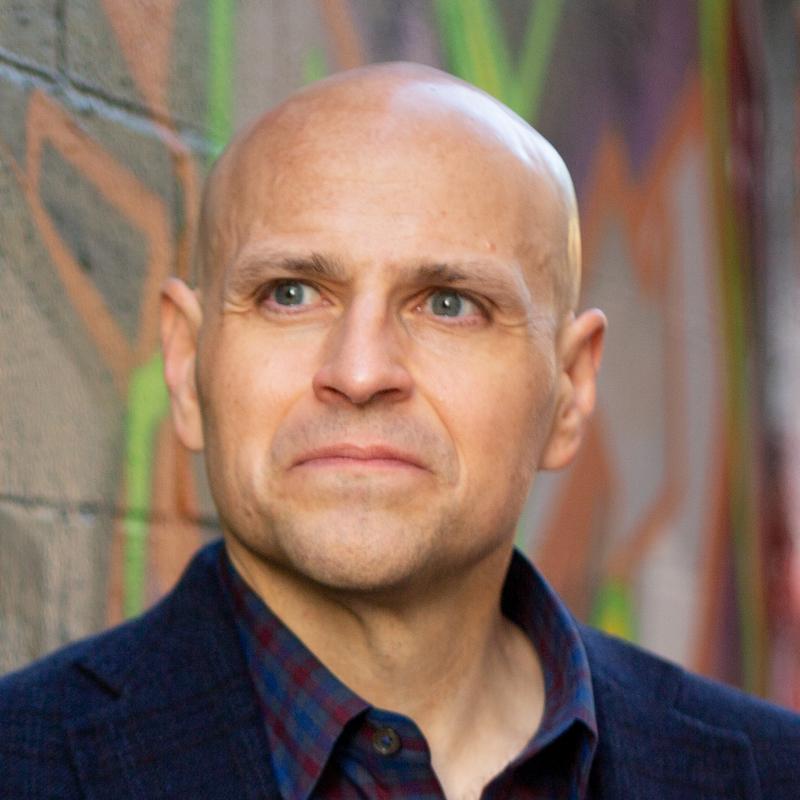You can see the full video from my keynote of this talk at the Mind the Product conference, San Francisco Davies Symphony Hall.
It’s February 13, 1960, and Ella Fitzgerald stands on a West Berlin stage, nearing the end of a stellar performance. On a whim, she decides to sing “Mack the Knife,” a popular song, but one she’s never performed live. The first chorus goes as planned, and then… she blanks and completely forgets the lyrics to the next verse. What do you do in her situation— choke up, end the song abruptly, or maybe just repeat the first chorus? Not the legendary Ella Fitzgerald. Instead, she begins to improvise:
ELLA FITZGERALD. Oh, what’s the next chorus, To this song, now? This is the one, now I don’t know. And now Ella, Ella And her fellas We’re making a wreck, What a wreck Of ‘Mack the Knife.’
February 13, 1960, Deutschlandhalle, West Berlin, Germany
Her band followed her lead and played along, never missing a beat, improvising along with her as she scats, impersonates Louis Armstrong, and begs the audience’s forgiveness in perfectly constructed verses. When the song ends the applause is so loud the audience must have exploded from their seats. Ella’s on-stage improvisation would earn her two Grammy Awards.1 That’s jazz: untidy, unpredictable, and utterly fantastic.
In the book Yes To The Mess: Surprising Leadership Lessons from Jazz, Frank Barrett—a management professor and accomplished jazz pianist—proves there is much product managers can learn from the way these musicians approach their craft. Jazz is messy. The musicians invent as they play, improvising with only the loosest of structure, and letting the music steer them. The performers don’t use sheet music. Prominent jazz artists, like Ella, flirt with disaster, night after night.2 Always improvising, they don’t know what they’ll end up with when they start. It’s uncomfortable. Sound familiar?

Ella Fitzgerald (Dizzy Gillespie looks on).
Photograph by William P. Gottlieb, Library of Congress (Washington, DC, 1947).
There is probably no better example than the best-selling jazz album of all time, Miles Davis’s Kind of Blue. Released in 1959, it still sells more than 5,000 copies a week.3 Even if you don’t know anything about jazz, you might recognize these tunes. Miles brought together a group of musicians at the top of their games—tenor saxophonist John Coltrane, alto saxophonist Cannonball Adderley, pianists Bill Evans and Wynton Kelly (on different songs), bassist Paul Chambers, drummer Jimmy Cobb, and, of course, Miles Davis on his trumpet.4
The entire album was recorded in two concise sessions—a total of just nine hours in the studio.5 That’s about one workday. To our good fortune, Columbia Records kept the original three-track tapes, allowing us to listen to the album taking shape. They capture the studio chatter, the coughing, the teasing, and the false starts. In this take from the song “So What,” drummer Jimmy Cobb flubbed a transition. He hit his cymbal too high up and too hard, and the crash is conspicuous. Listen at 0:12:
March 2 1959, Columbia 30th Street Studio, New York NY
As soon as he did it, Cobb knew he’d goofed. Such a dramatic crash might have kicked off fast-paced, hard-driving bebop solos, but Miles didn’t want to make a bebop album. Yet Cobb’s mistake was understandable—the musicians never played these songs together before, they hadn’t rehearsed, and they had little idea what they were going to play when they arrived at the studio.
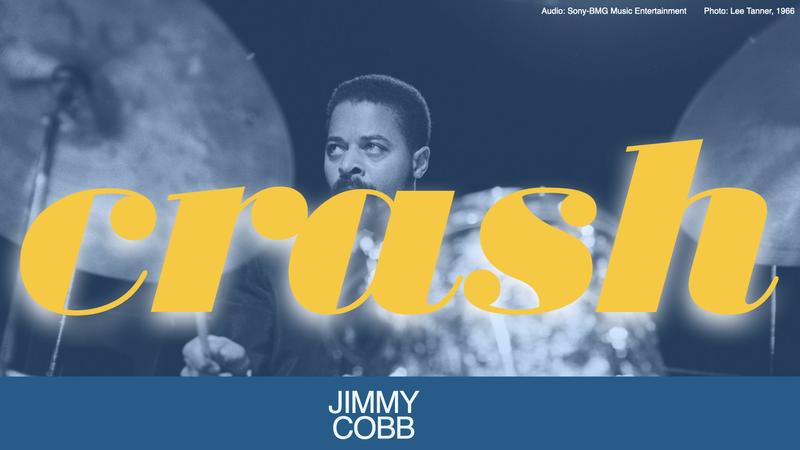
When they walked in, Miles handed the players slips of paper with only rough patterns and an overarching framework—a few chords, but mostly scales. Think of it as a rough spec, a PM mockup equivalent. To complicate matters, Miles wanted to break into a brand new direction—what would be called modal jazz, where less is more—so the patterns seemed foreign.6

Left to right: Tommy Potter, Charlie Parker, Miles Davis, and Duke Jordan.
Photograph by William P. Gottlieb, Library of Congress (Washington, DC, 1947).
Let’s listen in again. The producer, Irving Townsend, is in the recording booth. He stops the song because he’s picking up some unwanted background noise. We hear him speaking over the PA system:
IRVING TOWNSEND. Watch the snare too, we're pickin' up some of the vibrations on it… MILES DAVIS. Well that goes with it. TOWNSEND. What? DAVIS. All that goes with it. TOWNSEND. All right. [laughter]
March 2 1959, Columbia 30th Street Studio, New York NY
Irving Townsend sounds a little uncomfortable, and that was Miles’s intention. From the studio tapes we can tell that Miles wants the chaos. He wants the mess. He’s probing for discontentment and unpredictability. By pushing his ensemble into an unfamiliar zone, they’re more likely to create something meaningful. An average jazz performer would take the comfortable route and tighten up the background noise, but Miles wanted to send a message to the group. All that goes with it.
In a terrific talk where they both perform and speak, Jeff Gothelf and Jim Kalbach compared agile product teams to a jazz band. They observed three important features in common:7
- Patterns: each session starts with a rough blueprint, a set of loose patterns serve as guide rails. Kind of like a sprint. You can’t play good jazz from nothing.
- Empathy: jazz musicians use the term “Big Ears.” A performer is said to have Big Ears when they pick up on what the others are doing, anticipate, and create. Constant receptivity and active listening based on an emotional connection with their instruments and the others.
- Uncertainty: embracing uncertainty doesn’t mean playing whatever you want. The patterns are there to guide them. But it does mean that when you climb in the car, you don’t know exactly where you might end up.
Now that we understand how Miles guided the session, let’s return to Jimmy Cobb’s cymbal crash. Remember, Cobb assumed Miles would need to stop the take and start from the top again. Let’s listen to how Miles reacts:
March 2 1959, Columbia 30th Street Studio, New York NY
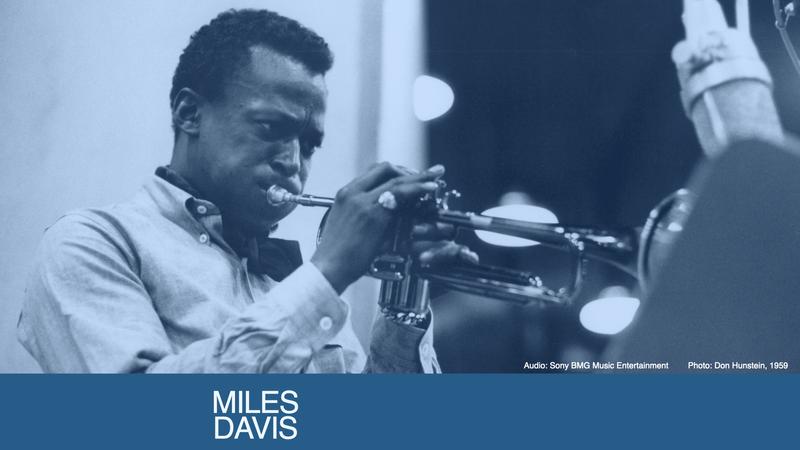
Miles Davis didn’t stop the recording. Instead, he launched into one of the greatest trumpet solos in history. The resonating cymbal seems everlasting, giving life to the trumpet and floating along. The crash made the solo even more exceptional. When we first heard the crash, it sounded like a mistake. But when Miles played the next notes, it became something else, something new. There would be no second take—this is what’s on the album. Cobb later said, “It must have been made in heaven.”8
Miles said, “If you’re not making a mistake, it’s a mistake.” In the words of jazz vibraphonist Stefon Harris, “There are no mistakes in jazz, every mistake is just a missed opportunity.”9 An ordinary leader would stop the tape and start over, trying for perfection. They would seek to avoid discomfort and stick to the plan. It took a tremendous leader like Miles to recognize the moment, take the risk, and create something glorious. Turning a mistake into an opportunity. Barrett calls this form of leadership “provocative competence,” where “the goal is the opposite of conformity: a leader’s job is to create the discrepancy and dissonance that trigger people to move away from habitual positions and repetitive patterns.”10
How many of you think of your job, as a PM, is “creating dissonance?” Making innovative products requires the same ability to surrender to the unknown, to follow the music wherever that goes. (If you want to see an excellent example of provocative competence in product leadership, read this letter that Slack CEO Stewart Butterfield sent to his team before they launched.)11
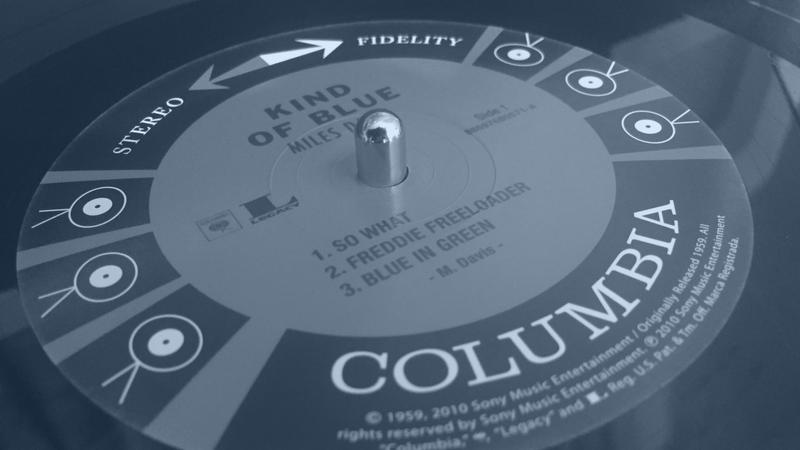
Our third example comes from Duke Ellington, another master of provocative competence. In Barrett’s book, the trumpeter Clark Terry recalled a story about Ellington, where Terry is struggling to find the right tone during a session:
One day, Ellington asked him to play like the trumpeter Buddy Bolden. “I said, ‘Maestro, I don’t know who the hell Buddy Bolden is!’ Duke said, ‘Oh sure, you know Buddy Bolden. Buddy Bolden was suave, handsome, and a debonair cat. Aw, he was so fantastic! He was fabulous! He was always sought after. He had the biggest, fattest trumpet sound in town. He bent notes to the nth degree. He used to tune up in New Orleans and break glasses in Algiers! … As a matter of fact, you are Buddy Bolden!12
Ellington is nudging Terry to go somewhere unexpected, somewhere uncomfortable. As Barrett notes, provocative competence is affirmative—Duke believes in Terry, more than Terry believes in himself. He was talking about Terry all along. We know we aren’t our best when we’re frazzled, but research shows that we also perform badly when we’re too cozy. The ideal performance level is in the sweet spot. It’s called “optimal anxiety” and was first recognized in 1908.13 The concept applies to everything from physical fitness to habit formation. This is what Google’s Larry Page calls being “uncomfortably excited.”
Miles, Ella, and Duke were adept at guiding their bands into the optimal anxiety zone, making them restless and opening up a space where they could create masterpieces. Such talent is also needed in product management. So much of what we’ve learned, our instincts, are to do the complete opposite. We’re told to minimize risk, communicate a clear plan, and document every step. As product managers, our most important job is to help our teams find the place of optimal discomfort—the goldilocks zone of ambiguity and uncertainty.
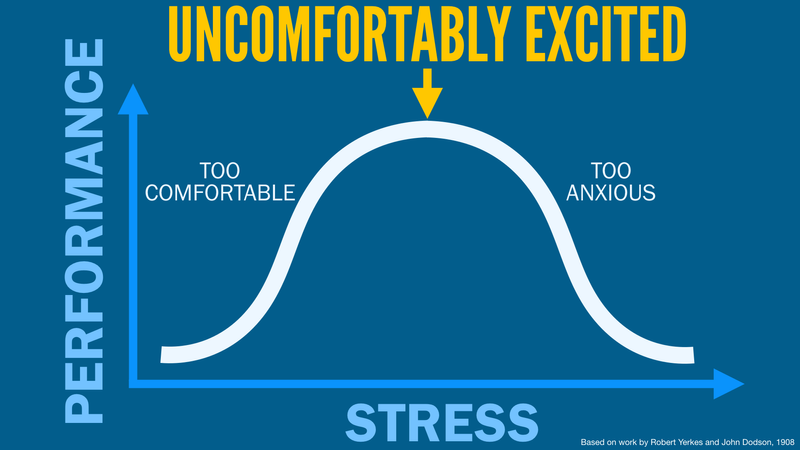
Google researchers undertook a massive multi-year research project to understand the effectiveness of teams. They wanted to know why certain teams at Google performed highly and others did not. Was it the size of the team? The blend of personality types? Or even their physical environments? Over time it became clear that who was on the team didn’t matter so much as how the team operated. More specifically, the social norms that determined whether or not everyone got a voice, and whether or not the team members felt that if they made a mistake, they knew it could be openly discussed without fear of embarrassment. Incredibly, group traits like “conversational turn-taking” and “sensitivity to nonverbal cues” matters more than the intelligence or experience of the team members.14 That’s encouraging news for those of us who don’t get to perform with John Coltrane and Cannonball Adderley.
There’s a term for this: psychological safety. The researcher Amy Edmondson demonstrated that teams can appear to be strong on the surface: people like and respect each other, and they get along well. Despite that, they may have an environment where everyone sits silently while the boss talks at them, or where people feel ashamed to be vulnerable and open up about their fears.15 They might all love hanging out together after work, but nobody can bring themselves to tell someone when they’ve got toilet paper stuck to their shoes. If we want a climate where people can accomplish groundbreaking things, we need to know our voice will be heard and where we’re not afraid to take risks.
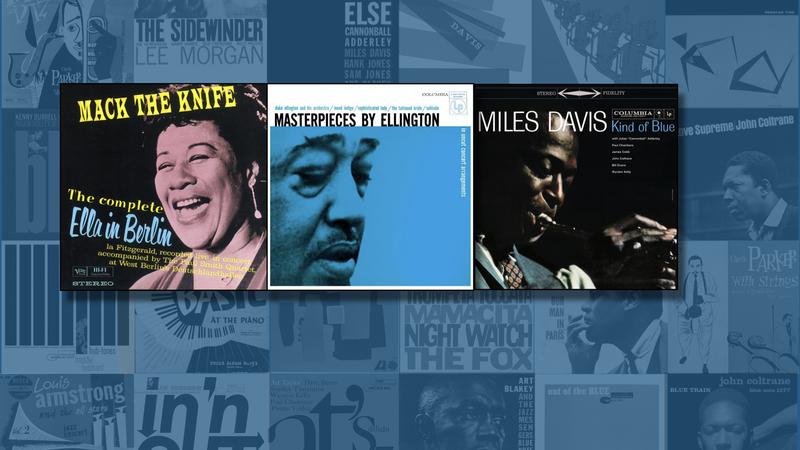
The best jazz bands, like the best Google teams, provide the space to take risks. We already know jazz artists have hyperaware senses and can pick up on nonverbal clues. But everyone also gets a voice. In jazz, it’s assumed that unexpected contributions can come from anyone. Getting a “voice” also means every band member takes a turn soloing. Each player spends time as both leader and follower. Miles was always attune to the contributions of everyone. If he realized someone hadn’t had a solo in a while, he’d lean over to them and whisper in his gravelly voice that they should take the lead.
Followership in jazz is worthy of the highest respect—it’s known as comping. Comping is listening and responding without overshadowing. Followership needs to be active, not passive. It’s not about sitting back and letting someone else do all the work. You take an indispensable role in giving space, riffing, experimenting, and supporting. And yet leading and talking are more valued than following and listening in our work culture.
(Note that psychological safety doesn’t always mean the leader is a joy to work with. Miles Davis could carry a grudge for decades. He was addicted to heroin and cocaine, and was abusive. Yet he was a genius at cultivating creative environments where everyone had a voice.16 Of course, this doesn’t mean you should be a jerk. It just means that being nice isn’t enough.)
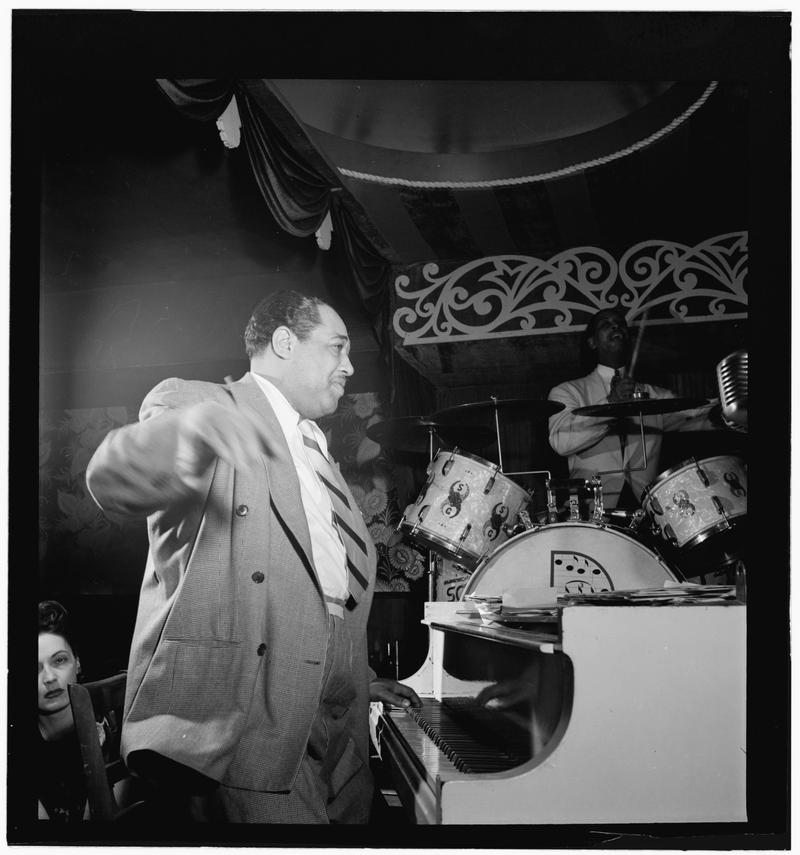
Duke Ellington.
Photograph by William P. Gottlieb, Library of Congress (Washington, DC, 1946).
What can you bring back to your job as a product manager? Here are three things to remember:
1 Get uncomfortable: Miles Davis nudged his musicians into a place where they were uncomfortable, the zone of optimal anxiety. What Larry Page calls “uncomfortably exciting.” When Duke Ellington challenged Clark Terry to play like Buddy Bolden. When Ella Fitzgerald thought, “uh-oh!” What Frank Barrett calls provocative competence: triggering people away from habit and repetition. Where there are no such things as mistakes, only missed opportunities. Embracing uncertainty when we make software, which is inherently unpredictable. We don’t know how our users, or our audience, will react, and that goes with it.
2 Listen carefully: jazz is a continual conversation where listening is more important than talking. Big Ears encourage empathy, knowing where others are going, and helping them get there. Looking for mistakes that can become new opportunities. You can help by listening more than talking, by being willing to ask questions when you don’t know the answers, even when you think you do. Celebrate following and listening in addition to leading and talking.
3 Let everyone solo: in jazz, everyone takes turns both leading and following. Psychological safety means everyone knows their voice is valued, and that they’re not afraid to try something risky. You can create this for your teams by demonstrating engagement, making sure each person speaks and is heard, picking up on unspoken emotions, and showing your understanding.
I hope you’ll go out and listen to Kind of Blue, preferably on vinyl. I also hope you’ll seek discomfort, to look for ways to push yourselves and your teams into the uncharted. Be psychologically safe, but out of your comfort zone. Where you’re uncomfortably excited. Where anyone can speak up. Where everyone takes a turn both leading and following, and that goes with it. All that goes with it. Because only by being uncomfortably excited can we create something new, something 10x beyond what we’ve ever seen before.
Can you make yourself uncomfortable? Can you play like Buddy Bolden?
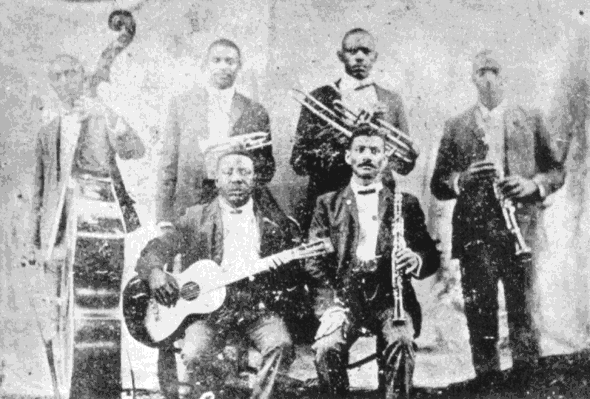
The only known photograph of the Buddy Bolden Band, circa 1905. Buddy is in the top row, second from left, holding cornet.
Unknown photographer, from the personal collection of trombonist Willie Cornish, donated 1938.
Recommended Reading
- Ashley Kahn, Kind of Blue: The Making of the Miles Davis Masterpiece
- Charles Duhigg, Smarter Faster Better: The Secrets of Being Productive in Life and Business
- Edgar H. Schein, Humble Inquiry: The Gentle Art of Asking Instead of Telling
- Frank Barrett, Yes To The Mess: Surprising Leadership Lessons from Jazz
- Miles Davis, Miles: The Autobiography
Recommended Listening
- Duke Ellington, Masterpieces by Ellington, 1951. (Spotify, Vinyl, CD)
- Ella Fitzgerald, Mack the Knife: The Complete Ella in Berlin (Live), 1960. (Spotify, Vinyl, CD)
- Miles Davis, Kind of Blue, 1959. (Spotify, Vinyl, CD)
- I made a Spotify playlist with these and many more songs from the era.
Thanks to Jake Knapp, Jeff Gothelf, Jenna Bilotta, Jennifer Dulski, Martin Eriksson, Rick Klau, and Summer Bundy for reviewing drafts. Brian Welle from Google’s People Analytics team helped me understand the research behind Project Aristotle. Frank Barrett’s book and other writings were indispensable and formed the backbone for my talk.
I also want to acknowledge legendary jazz photographer William Gottlieb, whose photographs appear on this page. In accordance with his wishes, his historic body of work was entered into the public domain after his death. His gesture is a priceless gift to jazz fans for generations to come.
Finally, thanks to Miles, Ella, Duke, Buddy, and all the talented cats who played with them for making so many marvelous mistakes.
-
Tim Tamashiro, “The Jazz Evangelist: how Ella Fitzgerald’s mistake made her a Grammy winner,” CBC Music, February 4, 2013. Accessed March 26, 2016.
David Andrew Ake. Jazz Matters: Sound, Place, and Time Since Bebop, (Berkeley: University of California Press, 2010), 47-8. ↩
-
“The best jazz players court disaster. They actively pursue not control, but its opposite—that moment of surrender to the music and all its possibilities, good and bad…”
Frank Barrett. Yes To The Mess: Surprising Leadership Lessons from Jazz (Boston: Harvard Business Review Press, 2012), 61. ↩
-
Ashley Kahn. Kind of Blue: The Making of the Miles Davis Masterpiece. (Boston: Da Capo Press, 2000), 194-5.
“The best selling jazz record of all time was released 40 years ago and it still sells 5,000 copies a week.”
Jim Luce. “Jazz Profiles from NPR. Miles Davis: Kind of Blue” on NPR. Undated. ↩
-
It’s hard to overstate how influential this crew was. They were the Dream Team of jazz—each of them going on to create important and historic works of their own. If anyone wants to argue with you that Kind of Blue isn’t the greatest album of all time, chances are they’re advocating for John Coltrane’s A Love Supreme.
“If you like Kind of Blue, turn it over, look who plays on it,” says keyboardist Ben Sidran. “If you particularly like the piano, go buy a Bill Evans record, buy a Wynton Kelly record. If you like the alto playing, buy a Cannonball Adderley record. That one record—it’s not even six degrees of separation—is maybe two degrees of separation from every great jazz record.” “The 100 Jazz Albums that Shook the World,” from Jazzwise Magazine, September 2009. ↩
-
Miles Davis. Miles: The Autobiography, (New York: Simon & Schuster, 1989), 234. ↩
-
It’s difficult to find accessible explanations of modal for laypeople (like myself) that have only a passing familiarity with theory. I particularly liked this explanation from a Reddit user: “Modal Jazz is a subgenre in which the musicians emphasize the use of a small number of notes, a mode, over chord progressions. Think melody over harmony.” Thanks, Woobassguitar. ↩
-
Jeff Gothelf and Jim Kalbach. “Jeff Gothelf and Jim Kalbach play and talk Jazz at Re:Design 2014,” YouTube video. Published May 9, 2014. ↩
-
There are conflicting accounts about whether or not the crash was intentional, but Jimmy Cobb has consistently stated in interviews that he considered it a mistake at the time. Since Cobb is the last musician alive from those sessions, I’m taking him at his word:
“Cobb said later that he knew it was a mistake immediately and assumed that they would have to retake the recording.” See Frank Barrett. Yes To The Mess: Surprising Leadership Lessons from Jazz (Boston: Harvard Business Review Press, 2012), 45.
“I thought it was a mistake at first! I thought it was too loud!” See Ashley Kahn. “Jimmy Cobb: The Reluctant Don.” JazzTimes, November 2003.
“I thought I had made a mistake by hitting the cymbal too high up and too hard.” See Marc Myers. “Interview: Jimmy Cobb (Part 3),” JazzWax, January 7, 2009.
“As Jimmy Cobb remembers this recording date: ‘It must have been made in heaven. All Miles did was tell each musician ‘You play like this up to here and then you modulate to here and then you come back to this. Okay, let’s do it.’ And we just went ahead and did it.’”
Eric Nisenson. Round About Midnight: A Portrait of Miles Davis, (Boston: De Capo Press, 1982), 160. ↩
-
Harris, Stefon. “There are no mistakes on the bandstand,” TED Talks, November 2011. ↩
-
Barrett (2012), 139. ↩
-
Barrett (2012), 139. ↩
-
Melinda Beck. “Anxiety Can Bring Out the Best,” in The Wall Street Journal, June 18, 2012.
Robert M. Yerkes and John D. Dodson. “The relation of strength of stimulus to rapidity and habit-formation,” from Journal of Comparative Neurology and Psychology, 18, 1908, 459.482. ↩
-
Charles Duhigg. “What Google Learned From Its Quest to Build the Perfect Team,” The New York Times Magazine, February 26, 2016. ↩
-
Amy Edmondson. “Building a psychologically safe workplace: Amy Edmondson at TEDxHGSE,” YouTube, May 4, 2014. Accessed March 23, 2016. ↩
-
Barrett (2012), 123. ↩
